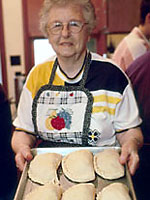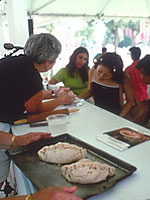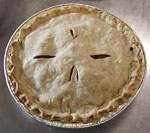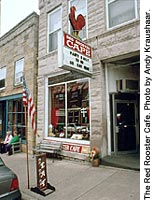|
Home | Search | The Artists | Teaching | Hiring | About This Site | Contact Us |
||||||||||||||||||||||||||||||||

Dorothy’s |
Pasties Lots of Ways to Make Good Pasties Do you know people who care about making good food? Do they try to use the perfect ingredients, search for excellent flavors, make sure to cook the dish just right, and love to see other people eat what they make? That’s what Dorothy did with her pasties! Good cooks try to perfect their dishes, and that includes people who make pasties. Pasty makers try new things. They add less flour or more water in their crust. They leave out carrots or put in rutabaga in the filling. Pasty makers have to decide how they’re going to shape the dough. There’s no one right or wrong way, just lots of different preferences by different cooks.
Other cooks make pasties in other shapes. If you go to this restaurant in Mineral Point,
you’ll be served pasty made
Then and Now With so many different ways to make pasties, you might be wondering: “How can I tell what is a pasty and what isn’t?” Here are three basics— The ingredients should be raw, not pre-cooked, when they go into the rolled-out dough. The crust should be made with flour, shortening and water. (Dorothy used lard for her shortening.) The pasty should be baked. (Dorothy baked her pasties at 350º F for one hour.) In Wisconsin, pasties began as a Cornish food eaten by miners in southwest Wisconsin. Today, pasty makers and eaters are people from many ethnicities and different parts of the state and region. Let’s look at this contrast—
|
For Educators: |
||||||||||||||||||||||||||||||
|
“I do not use a pastry blender. I like the feel of the pie crust. I like to do it with my hands because I know by the feel of the crust whether it is mixed enough.” – Dorothy Hodgson |
||||||||||||||||||||||||||||||||
|
Home | Search | The Artists | Teaching | Hiring | About This Site | Contact Us |
||||||||||||||||||||||||||||||||



 Dorothy also
made pasties that are like a pie. She makes these when a group of people eat together, family style.
Dorothy also
made pasties that are like a pie. She makes these when a group of people eat together, family style. in a long pan, like lasagna. That’s fine in a restaurant where you’re sitting at a
table with forks and knives. But that style would have been hard for the miners to eat. For them, pasty was the perfect meal because it came in its own wrapper (the crust) and it didn’t need to be
eaten with silverware.
in a long pan, like lasagna. That’s fine in a restaurant where you’re sitting at a
table with forks and knives. But that style would have been hard for the miners to eat. For them, pasty was the perfect meal because it came in its own wrapper (the crust) and it didn’t need to be
eaten with silverware.